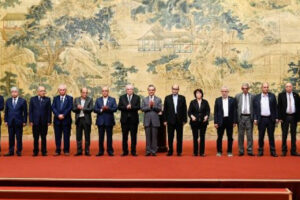Qatar is gearing up for a World Cup tourism boom as the tiny Gulf state prepares to welcome more than a million soccer fans. One complication: many of them can’t or won’t stay there.
An accommodation squeeze means tens of thousands of fans will base themselves in nearby countries for the month-long tournament. Match-day flights from major Middle Eastern cities will shuttle spectators to games, benefiting airlines, hotels and hospitality venues across nations including the UAE, Saudi Arabia and Oman.
The already popular tourism hub of Dubai stands to benefit the most. Of the more than 90 new flights that will land each day in the host city, Doha, about 40 will leave from the UAE. A new hotel built on the Palm has been set aside for guests who plan to base themselves in Dubai and take the 40-minute flight to Doha with streamlined immigration procedures.
Dubai will be “the major gateway” to the World Cup with probably more people coming through the city than Qatar, said Paul Griffiths, the CEO of Dubai Airports. “The amount of hotel capacity in Qatar is fairly limited and we’ve got so much to offer here.”
Qatar has been preparing to host the Cup for 12 years and estimates the influx of 1.2 million visitors will add $17 billion to its economy. Amid concerns of an accommodation crunch, organisers have leased two cruise ships and will pitch more than 1,000 tents in the desert. A regional shuttle service will connect Doha with other cities including Muscat, Riyadh, Jeddah and Kuwait City.
Saudi Arabia and Oman are both holding festivals to entice fans and plan to streamline travel procedures. The Saudi Tourism Authority says it expects to welcome 30,000 visitors because of the World Cup, and those registered for Qatar’s Hayya fan card can apply for multiple-entry visas to the kingdom.
Meanwhile, Oman’s Ministry of Heritage and Tourism says the tournament will “raise the profile of many regional destinations” and have an economic impact well beyond the event.
FIFA and Qatar have both welcomed the tourism benefits that will flow to the region.
Compact event
The busiest period for Qatar will be the group stage, when four matches a day will be held in stadiums in and around Doha. Two of the venues are just a 10-minute drive apart, while the furthest is just an hour away. That makes the event more compact than the 21 World Cups that preceded it.
Russia, which hosted the last tournament, had stadiums spread over 11 cities, while Brazil held matches in 12 cities. For the 2026 World Cup, Mexico, Canada, and the US will share hosting responsibilities.
A compact tournament offers fans the opportunity to watch more than one match in a day, said Alan Holt, managing director of Expat Sport. Holt, who slept on a gymnasium floor in Japan during the 2002 World Cup, and shared a one-bedroom apartment with four friends in Moscow in 2018, said accommodation shortages for such a huge sporting event are nothing new.
And World Cup fans have shown time and again they’re prepared to travel for matches.
“I expect for first-time visitors to the region to leave impressed,” Holt said. “For some people this is a bucket-list experience, for others it’s a four-year trip with friends and for many it’s an opportunity to come to a different part of the world than they previously had.”















